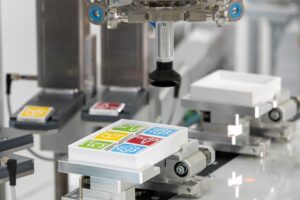Good design, by definition, improves functionality. It is not just about the aesthetics. At its best, when the combination of form and function is successful, the user can utilize the product well, that is to say intuitively and smoothly, because it has been thoughtfully designed to achieve the object’s purpose. This holds true for anything from the humble chair to a kitchen utensil, or, as in our case, a HMI screen.
HMI screen design should not be dismissed as an afterthought as it has a direct impact on operational efficiency. The better the screen design, the more efficient the operator can be. Producing a good and user-friendly screen design, however, has not always been simple to achieve. When the HMI was first introduced nearly 30 years ago, designing the screens required computer programming by people with advanced computer knowledge and software programming skills. Its development and maintenance made the process time consuming and expensive.
HMI screen design has thankfully advanced since those early days in the 1980s, evolving through a number of stages – we call them HMI Design 1.0 – 4.0 – from a laborious, manual process to one that is automated, using the latest screen design software which offers users the ability to select from pre-configured display options to expedite the process. Layout and template features in the software now give users new-found freedom and flexibility to create a better interface faster, ultimately getting the HMI up and running more quickly and efficiently. The new screen design software is simplifying this process and dramatically reducing the time necessary to design effective screens. Less time and less effort means less cost and more productivity, sooner. Clearly, this is something worth exploring in more detail.
An analysis of user data on HMI design time reveals that the number of screens (base screens) on a large HMI typically exceeds 500. The number of parts per screen usually exceeds 100. Considering the time and effort it takes to create each part, it is easy to see how time consuming it becomes to design a screen.
Instead of having to design a screen from scratch, the concept of today’s HMI Design 4.0 is to use templates with features and appearances that are all pre-set for efficiency. You can significantly reduce the time and effort required for HMI design by using theme templates for appearance (look & feel), color set for color tone, and navigation for screen change. And because these templates can be changed even after the HMI’s design is completed, fine adjustments can be made without affecting the entire design.
These days, automation users demand more from their HMI, and the user interface has become more important than ever as it is directly linked to production efficiency. Some aspects of HMI screen design, such as communication settings with the PLC and script processing in HMI design procedures, still require some time and effort, but the innovative capabilities of HMI Design 4.0 are now making HMI design a much more efficient process. The result is a more successful product that directly impacts on operations for the better.
To learn more about leading the way in HMI Design 4.0 check out this new white paper Simplifying & speeding up HMI screen design is finally a reality.




Conversation
Awesome post thank you for sharing
Thank you for taking the time to comment, I am glad you enjoyed the blog and hope you try to play Vijeo XD V3.0 which will be released on end of this year.
Good Information, Thanks For Sharing.